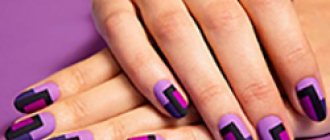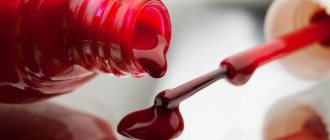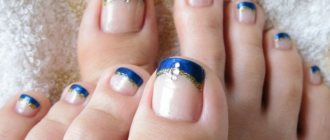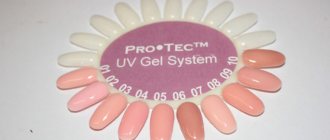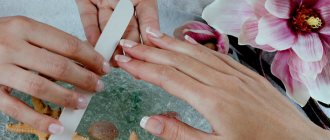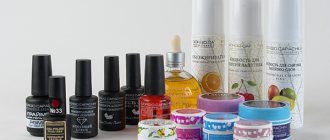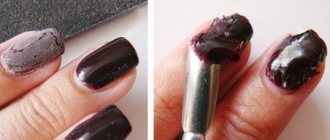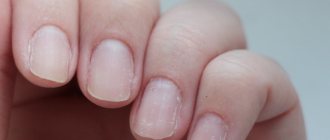Single-phase and three-phase gel polishes today are the most popular means for creating a beautiful, neat manicure for a long time. Many girls believe that high-quality nail designs can only be created in a salon. In fact, every lady can apply a single-color coating, complemented by simple decorations, herself at home. Following the technology of applying gel polish and using high-quality products will allow you to create a neat manicure for more than 2 weeks.
Application of three-phase gel polish
Main differences
What does single-phase application system mean? Simply put, this is a three-component product, which includes a base, color and finishing layer. With its help you can do a quick manicure, and such a bottle will take up little space in your cosmetic bag.
A manicure using this gel will last about two weeks. But not all nails accept it, and accordingly, the durability of the coating may be less. A trial application will determine if the product is suitable for your case.
What is three-phase gel polish? This product consists of three different bottles:
- base;
- color;
- fixative
The base coating has the same principle of operation as double-sided tape. At the same time, it strengthens the nail and holds the color well. The fixative performs the function of fixing the color and protecting it. The fixing layer can be matte, glossy or have a scent that remains on the nails after drying.
Three-phase gel is a suitable option for those who like to decorate their nails with stickers.
What is three-phase, single-phase, two-phase gel polish and how do they differ from each other?
A neat, neat and visually attractive gel polish manicure has become a familiar way of decorating nails for modern girls. This coating attracts with its durability and resistance to damage, choice of colors, shades and textures. Shellac nails are convenient, practical, save time, and allow you to get the perfect result. Manufacturers of durable polymer coatings produce three types of gel polish systems: three-phase, two-phase and single-phase. They differ in coating composition, durability, and method of application of materials.
What is single-phase gel nail polish? This is a coating with a combined structure consisting of a base, top, and color pigment. The texture of such materials is very liquid; they do not overload the nail plate. Due to the smaller number of layers applied in thickness, the design with single-phase gel polish is more comfortable for everyday wear. The advantages of choosing single-phase gel polishes also include:
- manicure with them looks softer, more aesthetically pleasing and neater during the entire 2 weeks of wear;
- the composition of this decor is unique and environmentally friendly, it does not cause injury or damage to the nail plate;
- The procedure for removing a design by soaking occurs faster with single-phase shellacs, without leaving microdamages and marks on natural or extended nails;
- the procedure for decorating nails is less time-consuming: depending on the density of the selected flower bed, you will have to spend less minutes drying it in a UV, LED or hybrid lamp than when working with 3-phase gel polishes;
- manicure and pedicure with single-phase gel polish will not require significant investments in the purchase of additional materials, liquids and special products (base, fixative, preparation for removing the dispersion layer, materials for leveling the nail plate and building its correct architecture);
- single-phase gel polishes will be a good choice for clients who cannot devote much time to a manicure. The number of collections of these gel polishes from different manufacturers is as large as for the three-phase system, the color palette is also interesting and multifaceted;
- If the client’s nails are naturally strong and healthy, coating them with a single-phase material will last as long as other types of systems. High-quality single-phase gel polish strengthens natural nails well and protects them from injury, remains resistant to chipping and detachment at the side ridges and cuticle area;
- the quality of single-phase shellacs allows the natural nail under the material to practically not become thinner (since such gel polish allows oxygen to pass through to the nail plate better);
- The single-phase system is better for getting started with durable resin coatings, especially for at-home designs or novice DIYers. The application technology is easier and simpler, nail art techniques are easier to practice, and the cost of the final manicure is comparatively lower than that of three-phase gel polish.
As for the disadvantages of this system of materials, these include the following points:
- Due to its liquid texture, gel polish can form streaks, so you need to work with it slowly and carefully, and apply it in a strictly thin layer;
- With single-phase gel polish alone, it is impossible to level and form an ideal apex or improve the shape of natural nails. All these operations are performed with special bases and tops, the component composition of which is not included in the standard formula of single-phase units. The structure of single-phase gel polish and the design tasks that can be performed with its help are as simple as possible;
- This system is not suitable for thin and fragile nails. When worn, the design is likely to peel off and become deformed;
- single-phase gel varnishes do not have an increased durability. Their limit is 14 days from the date of application. However, with intensive use, a manicure that lacks a separate top protective layer may begin to chip and crack even earlier. Those at risk are primarily girls with long nails or those with naturally soft nail plates;
- Since a single-phase material is a mixture of layers of base, top and colored shellac, it will be difficult for a non-professional to complete the finishing alignment to form an ideal highlight. Enamel shellacs are especially capricious in this regard. To do this, as well as to increase durability, you will still need to use another layer of topcoat from a three-phase system;
- The single-phase system also differs from the other two in that it is difficult to perform complex work with such coatings, especially with the use of decor applied to a sticky layer. Single-phase materials do not have residual dispersion, which means that in order to decorate them in an original way with rhinestones, sparkles, kamifubuki, transfer foil and other decor, the craftsman will need decorative glue, thick gel or a gel polish fixer;
- Not many manufacturers spend time and resources on developing single-phase systems, so it is difficult to find gel polishes of the appropriate quality of this type. Single-phase system materials from the brands Irisk, Masura, RuNail, TNL, Patrisa nail have earned good reviews. But they are not suitable for all clients, especially those with allergies.
The next type is two-phase gel polishes. What is the fundamental difference between single-phase and two-phase gel nail polish? When performing a manicure in a two-phase system, the nails are first treated with a base. It must be dried in a lamp, and only after that the selected shade of the decorative coating must be applied. With such coatings, it is easier for the master to correct flaws and aesthetic defects of natural nails, to perform extensions or repairs with a base before applying a manicure. All the disadvantages inherent in single-phase gel polishes are also relevant for this system. Moreover, finding safe and high-quality material in online stores or offline sales is even more difficult. The best manufacturer of two-phase systems that can be worn without risks by allergy sufferers is the CND company.
The most favorite among craftsmen and their clients is the three-phase shellac system. What does three-phase gel polish mean? The name is due to the number of layers of material applied: base coat, color composition and fixer. This manicure is much more durable. With strict adherence to the application technique, it can last on the nails in its original form for up to 4 weeks or even more (depending on the rate of nail growth and the care with which the design is handled). The main advantages of a three-phase system include:
- resistance to various external influences (weather, mechanical damage, etc.). The final coating, which is the final step in creating nail art, protects it from abrasion, loss of gloss and scratches;
- the need to update your manicure less frequently due to the properties of the base and top, which ensure maximum adhesion of all layers of the design between each other and the surface of the nail plate;
- The significant advantage and difference between single-phase and three-phase gel polishes lies in the greater space for maneuver. With three-phase shellac, the master is not limited either in the choice of decor or in the ability to correct any imperfections in the nails to make them long and beautiful;
- Many three-phase gel polishes have a medium-thick consistency, which is more convenient to work with. This material is distributed faster, more evenly and uniformly over the nail, without streaks or bald spots, without staining the cuticle and side ridges.
The disadvantages of this type of gel polishes are:
- time-consuming. Each layer of coating must be applied and dried separately, working carefully and carefully so that the manicure lasts at least 3-4 weeks, promised by the manufacturer;
- the price of the design, which consists of the time of the master, the three types of materials used, as well as the equipment used for preparing nails and drying coatings;
- the need to take professional courses in order to fully master the capabilities of each coating;
- the difficulty of selecting a brand and its collections that may be suitable for sensitive and allergic nails. Unlike single-phase gel polishes, which have no residual stickiness, with three-phase gel polishes the risk of cumulative allergy to the dispersion is much higher.
Tip: as a rule, the coating on your feet lasts much better than on your hands, so use single-phase gel polishes for pedicures. You will save time on the procedure, and the coating will last 10-14 days! Also, single-phase gel polish can be used in a three-phase system using a base and top coat, if you really like the shade, but are not satisfied with its durability.
Don't know which system to choose, which one is better? In our review, using three-phase and single-phase shellacs from the Bluesky brand as an example, we will look at the advantages and disadvantages of each of them.
Application process
To prevent the coating from deteriorating in the near future, you need to know how to apply single-phase gel polish:
- You should start by removing the old coating and giving your nails the desired shape.
- Treat the nail plate with a fine-grained buff. This will make it smoother, which will improve the quality of the coating.
- Wipe your nails with a cotton pad soaked in degreaser.
- Push back the cuticle.
- Apply the first layer without touching the periungual ridges and cuticle. The tips of the nail should be carefully painted.
- You can dry your nails in an LED (1 minute) or UV lamp (2 minutes).
- Before applying the second layer, the cuticle is pushed back again. This will make your manicure perfect.
- Apply the next layer with the same care as the first. Dry under the lamp.
After the procedure, you can treat the cuticle with a special oil. This will soften the skin and soothe it.
The differences when covering nails with three-phase gels lie in the step-by-step separate application of each product:
- After preparing the nail plate, it needs to be degreased and disinfected. This will eliminate the risk of fungus appearing under the coating.
- To improve the adhesion of the gel polish to the nail, a special primer is applied. It is better to choose an acid-free one, which does not spoil the structure of the plate. Drying is not necessary at this step; the product will dry on its own within 20 seconds.
- The base is applied in a thin layer over the entire surface and then dried. 2 minutes if using a UV lamp and about 30 seconds under an LED lamp.
- The color layer is also applied thinly. Drying time is the same as in the case of the base. A primer that improves adhesion to the next layer should also be present.
- The fixative coating is thicker than the others. Therefore, after application it is better to dry your nails additionally. This will extend its service life and eliminate the risk of damage.
The service life of such a manicure is from two weeks.
Important! Whichever of these products you use, you need to pay attention to the quality before purchasing. The easiest way is to choose a gel by smell. A high-quality coating does not have a sharp unpleasant aroma, which indicates the absence of harmful impurities.
Brief overview of varnishes
According to their structure, varnishes come in three types:
- single-phase;
- two-phase;
- three-phase.
If you decide to choose a single-phase gel polish, then its application is not considered difficult. All layers, first – base, second – modeling, third – finish, were combined in one bottle of gel polish.
The two-phase structure is a little more complicated. Here, on the prepared nail we apply a base layer of varnish, followed by colored gel polish, which acts as the final layer. For this procedure, you should purchase two separate bottles.
The three-phase system already combines three main and irreplaceable components, and they are all complementary to each other. So, it contains:
- Strengthening base gel.
- Colored coating.
- Protective top - gel.
It is thanks to the “top” that the nails are reliably protected from the aggressive influence of the external environment.
Based on the multi-layer nature and properties of each component, three-phase gel polish is an excellent solution for strengthening and beautiful appearance of your manicure. Gel polish will not chip or lose color saturation, which cannot be said about regular polish. It is worth noting that three-phase gel polishes are absolutely odorless, which makes them safe and non-toxic for our body.
Pros and cons of single-phase gels
- A good result without unnecessary time expenditure.
- The application method excludes coating with a base and fixer. Therefore, you should not count on a long service life of such a manicure.
- During application, such varnish may drip, which causes difficulties when modeling nails.
- This product is not suitable for complex designs and decorations. The absence of a sticky layer does not allow you to show originality in the design of your manicure.
- Those with an elastic nail plate often experience cracking of the coating, so sometimes you have to additionally buy a fixer specifically for single-phase gels.
- Single-phase varnish does not dry out the nail plate and can be used even for weakened nails. However, this is not always good, because without the appropriate skills, nail modeling will not work.
- The finishing stage eliminates the formation of a sticky layer.
Completing the composition
Now we have come to the end of our procedure, which also takes place in several steps.
- Finish coating.
The coating is applied in a regular layer with the obligatory sealing of the end of the nail. If you have a manicure with rhinestones, we recommend applying a top coat in two layers - this will provide maximum protection to your convex jewelry. Then thoroughly dry each layer of applied varnish in a lamp. Hard and strong nails are guaranteed.
- Remove the sticky layer from the top coat.
For this procedure, it is best to use a cotton pad soaked in a special liquid to remove stickiness. But if you don’t have one at hand, you can use regular alcohol - the result will not disappoint you.
After all the procedures have been completed, your coating is ready. Three-phase gel polish, with careful handling of manicure, will be worn for several weeks, maintaining its original appearance.
By spending a little more time on a professional manicure with three-phase gel polish, as opposed to single-phase, we get a more lasting effect and better composition quality. Another positive feature of three-phase varnish is that it is easier to remove and does not stain the nail plate.
Pros and cons of three-phase coatings
- High strength is accompanied by a glossy shine thanks to the fixative. This varnish does not deform and looks as if it had just been applied.
- The complexity of the process does not always allow you to do a manicure at home, so you have to resort to the services of a professional master. The result is additional costs of time and money.
- Decorative elements on nails in the form of stickers require the use of only a three-phase application system. It is this method that allows you to firmly secure the decorations between the layers.
Attention! Regardless of whether single-phase or three-phase gel polish is used, the surface of the nails must be degreased before application. During the application process, be sure to remove any remaining product that gets on the skin near the nail.
Choosing the right gel polish
When visiting a salon, the master uses a number of products to treat the nail. This technology for creating a manicure is called three-phase.
It uses:
- base for coating;
- gel polish;
- top to consolidate the result.
Applying the base
In the average cosmetology salon, they only offer a color scheme to choose from. However, in some establishments, clients can also choose a base coat, because different brands differ in composition and degree of impact on the nail plate.
Modern expensive manicurists have gone even further - they allow the client to decide not only on the color scheme or the use of brands of materials, but also choose different nail designs. This is where you need to know the difference between single-phase gel polish and three-phase gel polish. By one phase we mean that during the manicure, not three different products will be used, but one universal one, which will significantly speed up the process and guarantee a more natural result.
Manicure products
Which product should I choose?
When the question arises, which is better, you should decide what is your priority. Beginners prefer single-phase gels. They are attracted by ease of use and pricing. In addition, for those who like to frequently change their nail color, this option will come in very handy. This is an affordable way to have a manicure for any life situation: be it a wedding celebration, or an ordinary friendly party. With this product you can look your best without being a professional.
More experienced people believe that it is better to spend time and money, which will later pay off in the form of a durable and original manicure. This option is good for those who cannot afford to do their nails often for a number of reasons. It’s easier for them to go to the salon once a month and get the desired result. Or, after spending time, do the same at home, if your skills allow. In this case, a thorough choice of a three-phase agent would be more rational.
Important! Always follow the storage conditions for bottles of gel polishes. Loose closures and dirty bottle necks will render the products unusable. They will lose their qualities, which will immediately affect the beauty of the manicure. Varnishes should be kept away from the sun and heating devices, and open bottles should not be placed near lamps for drying.
What does three-phase nail top mean?
Single-phase and three-phase gel polishes today are the most popular means for creating a beautiful, neat manicure for a long time. Many girls believe that high-quality nail designs can only be created in a salon. In fact, every lady can apply a single-color coating, complemented by simple decorations, herself at home. Following the technology of applying gel polish and using high-quality products will allow you to create a neat manicure for more than 2 weeks.
Application of three-phase gel polish
What you need for self-application
- There is no need to do hand baths before the manicure procedure. The point is the porous structure of the nail, which will absorb moisture. The time for evaporation will be about 3 hours, and applying the coating to a non-dried surface will promote peeling of the varnish.
- Take your time. Otherwise, miss an important point, which will cause the coating to be short-lived. Shooting and redoing it again is an additional challenge.
- Be careful. If you can handle simple varnish, then applying a gel coating will not be difficult.
- Buy a palette (these are artificial nails that you can apply polish on). After practicing on it, you will identify your weak points and be able to approach decorating your own nails more competently.
- Apply the gel, making the layer as thin as possible. Thick layers may shrink during the drying process, which will ruin the entire appearance of the coating.
Differences and properties of single-phase and three-phase gel polishes
Decorative gel manicure product with the properties of regular varnish and modeling gel. A wide range of colors makes it possible to mix gel polishes of different tones with each other, obtaining new shades.
According to the application method, the durable varnish coating is divided into single-phase and three-phase gel varnish, which polymerizes under the action of UV waves emanating from a certain type of lamp. If the technological process is followed, the gel layer forms a stable and dense surface that lasts on the nail plates for 10 to 20 days.
Review of manufacturing companies
On the modern market you can easily purchase gel polishes produced by companies such as:
- Irisk;
- TNL;
- Masura;
- Patrisa Nail;
- Khan;
- Bluesky.
The list goes on for a long time. Bluesky products are in unusually high demand. This option is supported by its reasonable cost and wide selection of shades offered.
The Korean brand TNL Professional is also quite popular. The optimal consistency of the product allows you to distribute it evenly and accurately over the entire surface of the nail. Consumers have the opportunity to choose from a variety of tones and colors. Representatives of the fair half of humanity often choose varnishes from the “Cat's Eye”, “Thermo”, “Morocco”, and “Mosaic” series.
Masura offers a wide range of single-phase and three-phase varnishes. You can use products produced under this brand at home and in the salon. The advantages of this manufacturer include the fact that the company produces formulations in small bottles. This is very convenient if you create a manicure at home.
Giorgio Capachini gel polishes are sold in 6 ml bottles. The consumption of the product is quite economical. The composition is enough to do a manicure 20-25 times. This is more than enough for home use. The varnish will not have time to get tired or dry out. To completely dry the layer, 1-3 minutes are usually enough, depending on the power of the device. You can remove the coating quickly and easily using a special liquid.
Irisk Professional gel polishes are distinguished by their affordable cost and high quality. The creator assures that they can last up to three weeks without cracks or chips. The company offers a wide range of colors.
Advantages and disadvantages
However, it is too early to draw final conclusions, because both single-phase and three-phase coatings have both advantages and disadvantages. In addition, it matters how the nails are prepared for coating. Only proper preparation will ensure proper results.
Who is the manufacturer of the varnish you choose also plays a big role. There are many unscrupulous manufacturers who produce low-quality and sometimes even harmful varnishes. Therefore, it is important to buy cosmetics, in particular nail polishes, only from trusted manufacturers, such as Masura, which are popular among professionals and amateurs.
Let's first talk about the advantages of single-phase coating:
- Ease of use. There is no need to understand the complex technology of applying three-phase coating.
- Polymerization in UV and LED lamps.
- Safety for the nail plate and nearby tissues, due to the absence of many harmful chemicals (toluene, formaldehyde) contained in other types of coating.
- There is no need to purchase a product to remove the sticky layer, since a sticky layer does not form in a single-phase coating.
- There is no external difference from a complex three-phase coating.
All the advantages described above make single-phase varnish an ideal option for both beginners and professionals in the field of manicure services. But, like any product, single-phase coating also has its drawbacks.
Firstly, in terms of stability, a three-phase coating, whatever one may say, will be superior to a single-phase one, due to the use of a base and a finish. These two layers ensure tight bonding of all components of the coating to the nail plate. Therefore, three-phase coating will find its adherents among those who do not like to frequently renew their manicure. Although, it must be said that, if desired, you can always extend the stability of single-phase gel polish using a finishing layer designed specifically for it.
The second disadvantage of single-phase varnish is the inability to give free rein to your imagination. Due to the lack of a sticky layer, it will be quite difficult to decorate the nail, which is so popular today. Here, perhaps, is all the information about the differences between three-phase and single-phase varnishes, knowing which you can easily decide on the choice of the nail coating that is suitable for you.
Modern technologies allow women to have well-groomed and seductive nails without much effort. Moreover, not all representatives of the fair sex have the opportunity to grow natural, long and healthy nails. It is in this case that you can use gel extensions. As a result of this procedure, nails may change their shape and length. In addition, they can be given the desired shade and decorative elements.
Gel extension technology involves the use of a special lamp with ultraviolet rays. The action of these rays turns the liquid consistency of the gel applied to the nails into a hardened material. In order for the nail to acquire the correct shape, templates or tips are used.
Ready-made templates are stickers and molds with markings that are used as a base for the gel.
Tips are plastic tips that are glued to the natural nail using special glue.
Gel extensions involve applying three layers:
- Basic: applied as a primer so that the future nail does not peel off.
- Modeling: it is used to form the correct shape.
- Strengthening: finishing layer for strengthening.
Therefore, depending on the number of products used, single-phase, two-phase and three-phase extension gels are distinguished.
Single phase gel
is a universal product that is suitable for use at all three stages of extension. It is perfect for beginners who are just starting to work with such materials. In addition, it is actively used by skilled professionals, as it has a number of useful properties:
- Strengthens weakened and thin nails;
- Does not cause allergic reactions or redness in people with sensitive skin.
Hand skin care
In order for the skin of your hands to maintain beauty and youth for many years, it is necessary to do skincare procedures. We will need:
- cuticle oil;
- hand cream.
At the end of the manicure, you need to apply cuticle oil. Place a drop of oil on the cuticle of each nail and rub well. Please note that there are mineral and natural oils. Mineral oil forms an invisible film on the surface of the cuticle. If you use this oil every day, you will get the opposite effect: the cuticle will begin to dry out. This oil is more suitable for masters: the client comes for a manicure once every 3-4 weeks, and mineral oil is ideal for single use. At home, on a daily basis, it is better to use natural oil, for example “Dadi Oil”, “ruNail”.
Organic oil for nails and cuticles Dadi Oil Famous Names 3.75 ml
After the oil, you need to apply a moisturizing or nourishing cream to the skin of your hands and cuticles.
NOTE! It is necessary to take care of your hand skin not only after a manicure! Before going to bed, smear your hands with a moisturizing or nourishing cream, and in the cold season, before going outside, with a protective cream. Once every 1-2 weeks you can scrub and perform paraffin therapy. To save time and money, you can purchase cream paraffin from “Aravia”.
Cream paraffin Flower nectar with flower and beeswax ARAVIA 300 ml
Let's look at the technology for using such a cream.
- Thoroughly scrub your hands to remove dead skin cells.
- Apply a moisturizing or nourishing cream and rub it in well.
- Apply a thick layer of paraffin cream.
- We put on plastic gloves and do not take them off for 15-20 minutes.
- After the specified time has passed, remove the gloves and wipe off the remaining paraffin cream with a paper towel.
After the procedure, it is advisable not to wet your hands for two hours.
Be sure that after such care your hands will tell you: “Thank you!”
Three-phase gel for extensions, how to apply. How to extend nails with gel?
How to extend nails with gel?
Gel nail extensions - step by step! What are the differences between single-phase and three-phase extension systems? How to grow your nails yourself?
How to choose a gel for extensions?
Single-phase units are usually preferred by beginning craftsmen. But some remain faithful to them over many years of work. Grattol gels have a viscous structure and are convenient to distribute over the surface of tips or molds. The pink opaque InGarden gel is perfect for a nude manicure; it is quite dense and does not show through. Beige single-phase from Vogue Nails is also a great option for nude; it self-levels and perfectly models the nail.
With experience, masters, as a rule, switch to a three-phase extension system. The widest palette of construction (modeling, sculpting) gels is perhaps from RuNail: the company has classic nude shades, and bright raspberry, blue, green and purple. As a base you can choose, for example, Kodi, and for the finish - Grattol with a sticky layer or Lianail, which is applied like a top coat and does not turn yellow after drying, which allows you to preserve the main color of the extended nails.
Gel nail extensions step by step
The technology for gel nail extensions in single-phase and three-phase systems is absolutely the same, only the gels themselves differ. Either you use a single phase gel for all three steps, or three different gels.
- We carefully treat our hands with an antiseptic, paying special attention to the fingers and nail bed.
- We do a manicure in the usual way and polish the nail plates with a buff.
- We degrease the nails, then apply a bonder (dehydrator) and primer.
- We prepare tips or forms. We cut the tips to the required length with a tip cutter and sand them with a buff to get rid of the smooth surface, then glue them onto the nails. We secure the forms firmly under the nails; they should not move during the work.
- Apply the first base layer of gel. In a single-phase system it can be immediately colored, in a three-phase system it is usually transparent. We distribute using a brush into tips or shapes, creating the correct oval/rectangle, depending on the desired shape of artificial nails. Dry the layer in a lamp.
- Apply a modeling layer of gel. It should not be too thick and lumpy, you should strive for an even distribution. Dry it again in the lamp.
- We grind the surface of artificial nail plates, giving them the desired shape, length and arch. Remove dust with a nail brush or napkin.
- Then we apply the finishing gel and seal the ends of the nails. The last layer is also polymerized in a hybrid lamp.
Now you can complete the gel polish coating and design. If you decide to do without coating and nail art, you can apply softening oil to the cuticle.
Reinforcement technology
Single-phase gel nail extension technology is carried out using tips and forms. Tips are part of the resulting nails, which are made of synthetic material – plastic. The forms are a disposable product with a paper base, which is attached to the nails during extensions.
Each type of extension accessory requires its own specific pattern. In general, the application and use of single-phase gel in such cases is similar, but the resulting effect may differ. Nail extension using this method requires the use of one jar of gel, which will be used to apply all layers. When applying the base layer, keep in mind that the consistency of this product is liquid.
But you can see what thermal nail polishes look like in the photo.
How to apply to the mold correctly
When building up, the first thing to do is to substitute the shape. This is done in such a way that movement and wobbling of the plate is eliminated. That is why this version of the material is provided with special marks that will allow you to choose the most optimal length for all nails. The advantage of this type of extension is that after the procedure, the claws will look as natural as possible.
- Using a special brush, the gel is applied to the plate using trampling movements. After this, the composition is applied to the seam. The same layer is used to form the required length of the nail. Next, drying is carried out until complete polymerization (exposure time is usually indicated by the manufacturer). Make sure that the material does not spread onto the cuticle and sides of the rollers. But you can read here how horsepower nail polish is used and who it is suitable for.
- After the first layer has dried, apply the second, dry, and then file the nail with a file. The surface should be sanded with the softest possible abrasive - buff, and then get rid of dust with a stiff brush. You should also learn more about the most popular gel polish design for short nails.
- At the third stage, a thin application of the same product is carried out. Be sure to ensure that the ends are sealed. After final drying in the lamp, the cuticle is varnished.
Gel nails are not only beautiful, but also durable. A well-executed manicure allows you to have beautiful, well-groomed nails for up to four months. But you should understand that they need to be corrected periodically.
How to build on tips
This type of influence is no less simple than building up forms. An important aspect of this procedure is the correct selection of tips. The shape must completely match the shape of the nail.
The extension is carried out as follows:
- An antiseptic is applied;
- The surface of the nail is polished;
- Tips are glued (from half to 1/3 of the nail, no less);
- The length of the tips is adjusted (using a file);
- A transparent layer of gel is applied and then dried in a lamp until completely dry;
- A thicker layer is applied again and dried again, but until complete polymerization.
Strictly speaking, all actions are not very different from using forms. It is also necessary to adjust the length and shape, ensure that the ends are tightly sealed, and also prevent the composition from getting on the cuticle and nail folds.
Let's get to know each other better: 1-phase, 2-phase and 3-phase gel polishes. Which to choose?
Indeed, they have a number of advantages that ordinary varnishes cannot compare to. But you will probably be interested in learning about their types, features and application techniques, and also choosing the most optimal one for yourself, especially if you do a manicure at home.
Gel polishes are divided into three main groups - single-phase, two-phase and three-phase. Let's start with the last one.
For whom is it better?
Extensions are suitable for girls who are not satisfied with the shape of the plate or if it is short in length; the specialist will do the work, taking into account the client’s wishes. On long nails you can draw a pattern or design of varying complexity. It looks interesting and gives the manicure originality. Rhinestones and bottles will hold up well, and various compositions can also be created with them.
Artificial nails are durable and rarely chip or crack. An ideal option would be for girls whose gel polish quickly chips off the nail for physiological reasons. The extensions are worn unchanged for up to 4-5 weeks, but it is better to make the correction at the right time so that problems do not arise.
Gel polish is suitable for any nails. It looks quite natural and is suitable for young girls and older women. If you apply a natural shade to the coating, you may not immediately notice its presence. Correction of this method is required only after 2-3 weeks. Some people like to wear extremely short lengths, in which case gel polish is the only option.
One of the most popular designs for medium length is French manicure or French manicure. In the nail service, this manicure is considered a classic and is in great demand.
The ability to do the procedure yourself at home. This is a big advantage compared to extensions. This allows you not only to save time and money and to be confident in the safety of the tools you use.
In general, these methods have almost the same technology. After analyzing the advantages and disadvantages of the methods, every girl will be able to choose exactly the manicure that is suitable for her nails.
Secrets of use
There are several secrets and subtleties in using polygels. By following them, you will certainly make it easier to work with the material and achieve excellent results in nail extensions and repairs. In general, extensions are not a simple process, since the master requires accuracy, attentiveness and dexterity. If desired, polygel is used not only in salons, but also at home, but the rules for use are strictly followed.
To get quality nail extensions with polygel, you will need:
- Carry out a manicure according to the standard scheme - classic, hardware. At the final stage of manicure, remove the pterygium.
- Treat the surface of the nail with degreasers.
- Apply a thin layer of base as this will act as an adhesive layer. Dry it and only after this stage lay out the acrylic.
- Wet the brush with clinser (alcohol) and wet it with a napkin. Squeeze the polygel onto the plate and distribute it according to the desired shape.
- Pull the remaining composition to the tip and remove with a brush. Knead the composition, stretch it as long as possible until it is fixed in the lamp.
